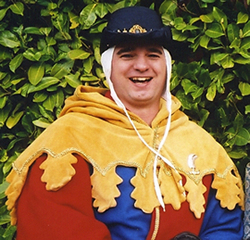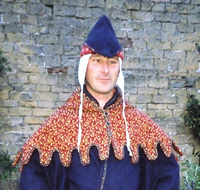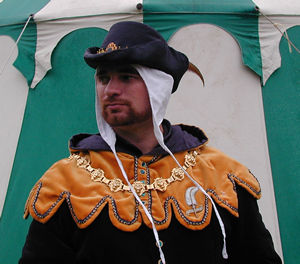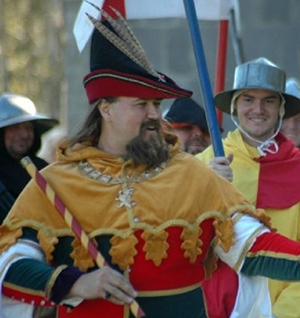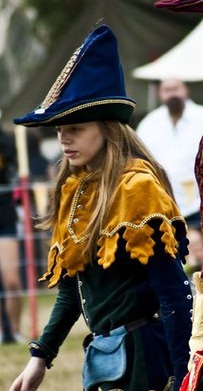
Historical Hats, Costumes & Accessories |
||
|
Home Crown Hood and Liripipe Man´s Cap Chaperon Torque Bycocket Crispinette Tressour Crispinette Nebule Templars Cross Tree Headdress Heart Shaped Hennin Attor de Gibet Jewelled Coif Hennin Flowerpot Hennin Halo Bonnet Reticulated Caul Flemish Hood Early Gable Headdress Tudor/Elizabethan Pouch Gloves Wedding Dresses Specialist Commissions Kats Kittens Authentic Effigy Based Headwear Miscellaneous Contact Links |
The Hood and Liripipe c.1100- onwards
By Richard I's reign, the hood was established and a small tail was beginning to be noticed at the back point of the hood. When Edward I came to the throne, the Hood and the Liripipe with its shoulder cape was very fashionable and sometimes the long hanging Liripipe would be bound and wrapped about the throat as a scarf on colder days, or if a man was working the Liripipe would be bound about his forehead like a turban, with the hood up. By Edward II's reign c.1307 -1327 the Hood and Liripipe were still worn in its usual manner, but sometimes (by a bored and foppish Dandy of court it is said) was turned onto its side and worn as a new hat, a Chaperon. Many accounts of hoods (aumuces) for low and high status occur during the period of Edward III in England and in France. In the Luttrel Psalter it has images showing hoods for the more 'average folk' and it shows a boy stealing fruit from a tree. He has climbed the tree and turned his hood back to front while still wearing it and loaded the fruit into his hood like a pouch or bag hanging around his neck. Often the Liripipe would have bells sewn to the bottom of it. This was because the wearer would hide their coins in their liripipes, but the noise would attract thieves - there are accounts of the liripipe being cut off completely, so bells would be attached to distract from the noise of the coins. Also "No common woman should go to market or without a hood" and "if you should come across a lady wearing 'a hood from brown scarlet studded with 154 stars of pearls and trimmed with gold, each star being crafted out of seven large pearls with an especially large one at the top of each star' have no doubt: she is a queen." Queen Philippa, on the morning of her Coronation wore a 'hood of fur' and for lunch changed and turned up wearing a completely different set of garments and with it 'wore a hood of miniver'. Fashion was changing rapidly. The author of the Brut Chronicle points out unhappily as he blames the 'Hainaulters in Queen Philippa's entourage' "Courtiers have dangling from their hoods trailing pieces of cloth" and "Nor the dagges of their clothing, nor the lengthening of their hoods." In c.1370 another writer wrote of a style of hood which seems to originate in England which spread throughout the continent with an extra-long liripipe which was at time knotted and "to have it hanging down your back like a normal hood in c.1360 is simply passť".
In one writ, March c.1334 Edward III ordered for himself and his courtiers
The Archbishop of Canterbury in c.1342 complained that the 'clergy were dressing in "checkerboard squares of red and green with linings in silk hoods"'. In France, Kathelot the Hatter was given pearls to decorate 3 hoods for fools in c.1351, as fools, 'Jean le fol' and another called 'Micton, fol de monseigneur le Dauphin', seemed to be "exempt from rules of clothing at court and wore garments of Noble or Royal status indicating they were treated in a very privileged way not typical of the distinctive costume belonging to a fools profession". Hoods were not only worn for a fashion statement with embellishment nor for practicality or to keep the weather off you but worn as part of a livery of a household with heraldic colours of the Lord with Heraldic device notifying everyone that they had that Lords protection. Hoods and Tabards also made it easy to identify which Scholastic college students belonged to in Cambridge and Oxford when they rioted with each other or town folk, as they were a form of uniform. Hooded teenage apprentice boys of London were considered the worst offenders and were the "scourge of the capital" in the C12th-C14th. An assault case in C14th state London youths dropped rocks into the liripipe and used it as a flail like weapon in street fights. Apparently this practice was not entirely uncommon, so hoodies of today are nothing new. In the city of Bristol it was decreed that prostitutes were to wear a hood of striped cloth, bearing red and in a c.1354 act of parliament given at Westminster "no common whore should wear any hood except rayed or striped with divers colours, nor should they wear furs, and their garment to be reversed to the wrong side outwards to set a deformed mark upon the foulness to make it appear more so". The sumptuary laws re-established these acts in 1382 and1437, when it was stipulated that the prostitute's hood should be red. In France in the C15th Prostitutes wore hoods with a very long peak. By Richard II's reign the Hood was continued to be very much worn and fashionable for all levels of medieval society and continued so in various forms either soft, wired or caned, attached to cloaks right up to our present day coats.
Headdress Design © 2001 - 2011|Site Design © 2005, 2006, 2007, 2008, 2009, 2010, 2011, 2012, 2013 All Items produced by Kats Hats © are subject to full copyright and may not be reproduced under any circumstances. Individuals have my permission to print single copies of the pictures or texts on this website for research for non-commercial purposes and private study provided Kats Hats © name, the copyright notice and this permission notice are preserved on all copies. Linking to this site is allowed without permission. For any other use please contact me. | |
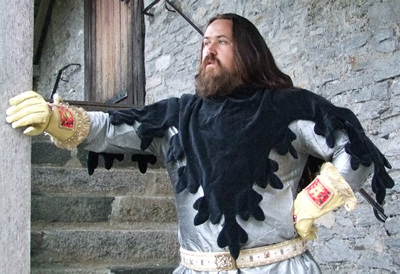 Hoods, in accounts have always appeared as 'aumuces' and have been worn for nearly 1000 years,
maybe more if you want to consider the Romans. The Vikings had a sort of hood/cape;
the Shetland people had very deep Hoods with massive fringes on the bottom of the fabric
to keep their arms and chest warm. The early Scottish had their plaid which doubled up as a hood in bad weather.
But the hoods that we started to know began to be cut as Hoods in the medieval period during c.1100-1154.
Both sexes of Royals, Nobles, Merchants, men at arms, Archers, children,
peasants and prostitutes wore them alike only differing in embellishment, cut, colour and quality of cloth.
Hoods, in accounts have always appeared as 'aumuces' and have been worn for nearly 1000 years,
maybe more if you want to consider the Romans. The Vikings had a sort of hood/cape;
the Shetland people had very deep Hoods with massive fringes on the bottom of the fabric
to keep their arms and chest warm. The early Scottish had their plaid which doubled up as a hood in bad weather.
But the hoods that we started to know began to be cut as Hoods in the medieval period during c.1100-1154.
Both sexes of Royals, Nobles, Merchants, men at arms, Archers, children,
peasants and prostitutes wore them alike only differing in embellishment, cut, colour and quality of cloth.



